Abstract
Have you ever left your bike outside in the rain? If so, you might have discovered unpleasant surprises afterwards—reddish-brown patches, known as rust, and your wheels, brakes, and gears might have stopped working so smoothly. In this chemistry science fair project, you'll learn why rust, a type of corrosion, is a serious problem. You'll also discover that not all rains are the same! Find out which ones can speed up the rusting process.Summary
Kristin Strong, Science Buddies
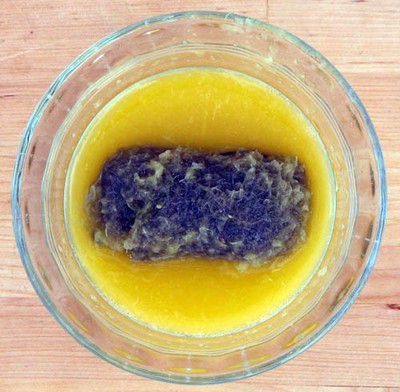
Objective
To determine how pH levels affect the rate of corrosion.Introduction
Have you ever been told to bring your bike in out of the rain? Have you ever wondered why? After all, rain is just water, so maybe the rain could clean your bike, right? The problem is that some parts of your bike are made of steel. Steel sounds like a strong metal, and it is, but the main element in steel is iron, and in the presence of water, iron combines easily with another element, called oxygen, to form iron oxide, also known as that reddish-brown substance called rust.
Rust changes steel into a different material, one that is weaker than the original steel. Rusting is a big problem because so many things people use every day are made out of steel, like cars, trucks, bridges, roofs, holding tanks, machinery, nuts, and bolts. When these objects are unprotected and exposed to water, they rust, and this damage costs the United States and Europe a lot of money—more than 3 percent of the value of all the things they make in a year. Yet steel continues to be widely used because it has an excellent strength-to-weight ratio—the best of all the common building materials—and it is non-flammable, resistant to mold and termites, does not expand or contract under temperature changes, and can be made with a consistent quality.
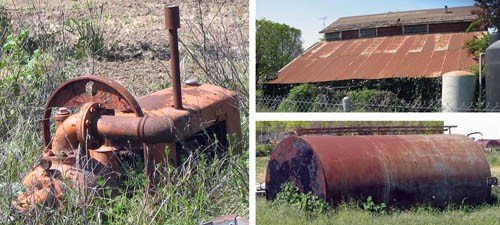 Image Credit: Kristin Strong, Science Buddies / Science Buddies
Image Credit: Kristin Strong, Science Buddies / Science Buddies
Figure 1. These are examples of steel machines and structures on a farm that show signs of rust (iron oxide) formation, a type of corrosion.
Rusting is an example of a process called corrosion. Corrosion means that a chemical reaction has occurred in which metal atoms have combined with oxygen to form an oxide coat. When those metal atoms are iron, the corrosion is "bad," because it corrodes quickly, weakening the original steel material. However, if the metal atoms are some other metal that corrodes more slowly, like zinc or chromium, then the corrosion can actually be useful, because the oxide coat that forms from the reaction with these metals can prevent the bad type of corrosion. That's why steel is often mixed with other metals, like chromium. As the chromium corrodes, it forms a protective chromium oxide layer on the outside of the steel that greatly slows the corrosion of the iron in the steel. It keeps your stainless steel pots and pans looking shiny, not rusty, even when they're exposed to water every day when you cook with them or wash them. Other ways to prevent steel from rusting are to paint it or embed it in concrete.
When iron and oxygen combine to make iron oxide (rust), heat is given off, which means the reaction is exothermic (exo means "out" and therm means "heat," so heat is sent out when the reaction occurs). With a thermometer and a timer, you can measure how fast heat is being given off (the rate), and that will give you an idea of how fast the reaction is occurring. In this chemistry science fair project, you'll investigate how acids change the rate of rusting as you compare a model of rainwater and models for acid rain. Acid rain is formed when sulfur and nitrogen compounds enter into the atmosphere. Sulfur and nitrogen compounds can be released into the atmosphere as a result of either natural events, like a volcanic eruption, or human events, like burning coal to run a factory. These compounds mix with oxygen in the atmosphere and form acids that combine with water droplets—the result is rain that is more acidic than usual. Normal rainwater has a pH of about 5.6; acid rain has a pH of 5.0 or lower. Ready to see what normal and acid rainwater might do to your bike parts? Let's get you started!
Terms and Concepts
- Steel
- Element
- Iron
- Oxygen
- Iron oxide
- Rust
- Corrosion
- Atom
- Oxide coat
- Zinc
- Chromium
- Exothermic
- Acid
- Acid rain
- Compound
- pH
Questions
- With what element does iron like to combine?
- What three things are required for iron to become iron oxide?
- Where is steel used?
- What two types of atoms combine during the process of corrosion?
- Is corrosion a bad process?
Bibliography
This source describes all the types of corrosion:
- American Galvanizers Association. Types of Corrosion. Retrieved October 10, 2017.
This source discusses how the corrosion known as rust (or iron oxide) forms:
- Howstuffworks.com. (2009). How does rust work?. Retrieved April 3, 2009.
These sources describe what acid rain is:
- United States Environmental Protection Agency (EPA) (n.d.). What is Acid Rain?. Retrieved October 19, 2017.
- # Link Name="EnvSci_p016.2" Value="HtmlAnchor" HtmlText="Acid Rain Students Site." #] (n.d.). Retrieved April 3, 2009.
For help creating bar charts, try this website:
- National Center for Education Statistics (n.d.). Create a Graph. Retrieved April 3, 2009.
Materials and Equipment
- Disposable gloves; available at your local drugstore or hardware store
- Timer
- Test tube with rim, 25 mm X 150 mm, Pyrex No. 9800; available at science supply stores, such as Edmund Scientific at www.scientificsonline.com, SKU#3081272
- Rubber stopper with 1 hole that fits the test tube, #3 size; available at science supply stores, such as https://www.homesciencetools.com
- Thermometer with a probe that will fit inside the rubber stopper hole, such as a kitchen thermometer
- Steel wool, finest grade available; available at hardware stores
- Scissors
- Ruler
- Choose two of the following acids. They should all be at room temperature and you will need 1 cup of each acid you choose.
- Lemon juice
- Vinegar
- Orange juice
- Tomato juice, unsalted
- Black coffee, in liquid form
- Distilled water, at room temperature and left exposed to the air for at least a few hours (1 cup); available at grocery stores
- Small bowls (3)
- Thin kitchen towel
- Tall plastic cup
- Lab notebook
- Graph paper
Disclaimer: Science Buddies participates in affiliate programs with Home Science Tools, Amazon.com, Carolina Biological, and Jameco Electronics. Proceeds from the affiliate programs help support Science Buddies, a 501(c)(3) public charity, and keep our resources free for everyone. Our top priority is student learning. If you have any comments (positive or negative) related to purchases you've made for science projects from recommendations on our site, please let us know. Write to us at scibuddy@sciencebuddies.org.
Experimental Procedure
- Before beginning your experiment, make sure that the distilled water has been opened and exposed to the air for at least a few hours. This will allow it to absorb some carbon dioxide from the atmosphere and lower its pH from a level of about 7 to about 5.8. The distilled water will act as a model for "normal" rainwater, which has a pH of about 5.6.
- The two acids you have chosen will act as two different models for acid rain, each with a different pH level.
- Make sure all your materials are at room temperature.
- Read all instructions before starting. Several of the steps need to be done quickly, one after the other, so you be familiar with all the steps before you begin.
Preparing to Test Your Rain Models
- Make three data tables for each of the rain models.
| Time (min) | Trial 1 Temperature (°F) | Trial 2 Temperature (°F) | Trial 3 Temperature (°F) | Average Temperature (°F) |
|---|---|---|---|---|
| 1 | ||||
| 2 | ||||
| 3 | ||||
| 4 | ||||
| 5 | ||||
| 6 | ||||
| 7 | ||||
| 8 | ||||
| 9 | ||||
| 10 | ||||
| 15 |
- Put on your disposable gloves to help prevent you from getting splinters from the steel wool.
- Using the ruler, measure 1 inch (in.) along the length of a steel wool pad. Cut across the width of the pad with the scissors at the 1-in. mark. Set the cut strip aside. Continue through the width of the pad, at 1-in. intervals, until it is used up. Repeat step 2 for two or more pads, or until you have a total of nine 1-in. strips of steel wool.
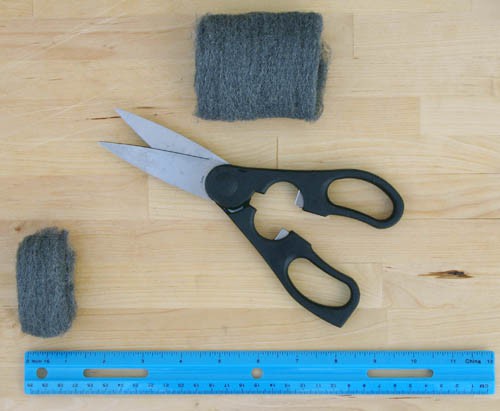 Image Credit: Kristin Strong, Science Buddies / Science Buddies
Image Credit: Kristin Strong, Science Buddies / Science Buddies
Figure 2. This photo shows how to cut a 1-in. strip off a steel wool pad.
- Pour approximately 1 cup of your first acid into a small bowl.
- Pour approximately 1 cup of your second acid into a second small bowl.
- Pour approximately 1 cup of the distilled water that has been exposed to the air for at least a few hours into a third small bowl.
Testing Your Rain Models
- Have your thin kitchen towel and plastic cup nearby.
- Thread the rubber stopper onto the thermometer probe, as shown on the right side of Figure 4.
- Place the rubber stopper, with its attached probe, inside the test tube. Record the temperature of the thermometer in your lab notebook. This will be your temperature at "time equals zero."
- Soak a strip of steel wool in the bowl of your first acid for 30 seconds (sec). It might float to the top of the liquid, so hold it under the surface with your fingers.
 Image Credit: Kristin Strong, Science Buddies / Science Buddies
Image Credit: Kristin Strong, Science Buddies / Science Buddies
Figure 3. This photo shows a strip of steel wool soaking in one of the acids.
- Remove the steel wool from the first small bowl and squeeze out the excess liquid for a couple of seconds over a sink.
- Immediately, remove the thermometer probe from the test tube and thread the soaked steel onto the thermometer probe, below the rubber stopper, as shown below. Twisting the probe as you thread it through the steel wool may help it go on more easily.
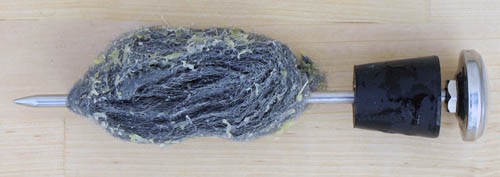 Image Credit: Kristin Strong, Science Buddies / Science Buddies
Image Credit: Kristin Strong, Science Buddies / Science Buddies
Figure 4. This photo shows how to thread the rubber stopper and steel wool onto the thermometer probe.
- Place the thermometer probe back into the test tube and press the stopper closed.
 Image Credit: Kristin Strong, Science Buddies / Science Buddies
Image Credit: Kristin Strong, Science Buddies / Science Buddies
Figure 5. This photo shows the thermometer probe with the soaked steel wool sealed inside the test tube.
- Wrap the test tube in a thin kitchen towel and place it upright in a plastic cup so you can read the gauge. The towel and cup will help retain any generated heat. Work quickly to set this up, because the reactions are already taking place.
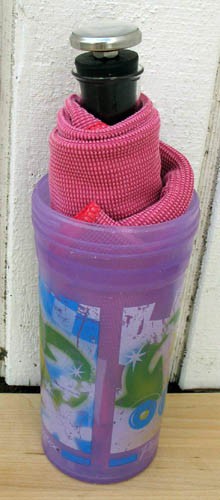 Image Credit: Kristin Strong, Science Buddies / Science Buddies
Image Credit: Kristin Strong, Science Buddies / Science Buddies
Figure 6. This photo shows the sealed test tube, ready to be evaluated.
- Start the timer and record the temperature every minute for 10 min., and then once more 5 min. later.
- Stop and reset the timer.
- Remove the probe from the test tube and examine the steel wool. Write down your observations in your lab notebook. Use the ruler to measure the greatest length of rusting observed.
- Throw away the steel wool and wash and dry the test tube. Rinse and dry the thermometer probe. Allow the test tube and probe to come to room temperature before doing any more trials.
- Repeat steps 1–12 two more times with your first acid, for a total of three trials.
- Repeat steps 1–13 for the second acid.
- Repeat steps 1–13 for the distilled water.
Analyzing Your Results
- For each time listed in each data table, calculate and record the average temperature.
- Using the table below, determine the pH of the liquids you tested and write them down in your lab notebook.
| Liquid | Approximate pH Level |
| Lemon juice | 2.2 |
| Vinegar | 3.0 |
| Lowest acid rain recorded in the Great Smoky Mountains National Park (1981) | 3.6 |
| Orange juice | 3.7 |
| Tomato juice | 4.1 |
| Average rain in the eastern United States today | 4.5 |
| Black coffee | 4.9 |
| "Normal" rain | 5.6 |
| Distilled water, exposed to air | 5.8 |
| Distilled water, fresh, not exposed to air | 7.0 |
- For each data table, make a line graph showing the time on the x-axis and the average temperature on the y-axis. You can make the graph by hand or use a website like Create a Graph to make the graph on a computer and print it.
- Based on your results, how did pH affect the rate at which heat was released? Which rain model produced the fastest temperature rise? Which rain model produced the greatest temperature difference between the ending and starting temperatures? Do you think steel rusts faster in normal rain conditions or in acid rain conditions?
- Did your rain models reach a "steady state," a point at which the temperature stopped changing? If so, make a bar chart showing the pH on the x-axis, and the final steady-state temperature on the y-axis. How did the steady-state temperature vary with pH?
Ask an Expert
Global Connections
The United Nations Sustainable Development Goals (UNSDGs) are a blueprint to achieve a better and more sustainable future for all.
Variations
- Investigate what happens to the soaked steel wool inside the test tube over a longer period of time, such as 24 hours. What happens to the temperature over time? Why do you think it behaves that way? What happens to the appearance of the steel wool? Measure the length of any changes that you see.
- Instead of using the pH table, shown above, to approximate the pH of the solutions that were tested, use pH paper (litmus paper) to measure the actual pH of the solutions that were tested.
- Try adding salt to the solutions to see if this affects the rates at which heat is released.
Careers
If you like this project, you might enjoy exploring these related careers:
Related Links
- Science Fair Project Guide
- Other Ideas Like This
- Chemistry Project Ideas
- My Favorites
- Acids, Bases, & the pH Scale










